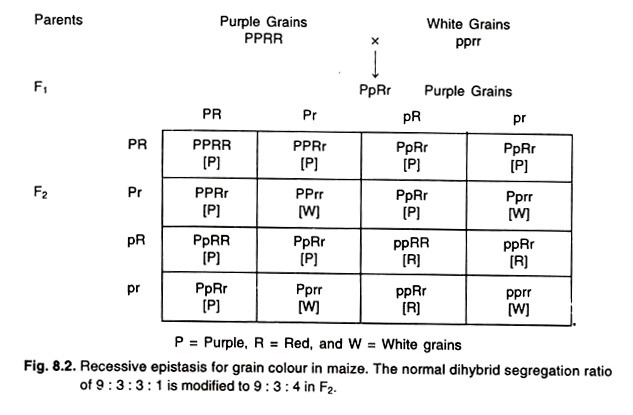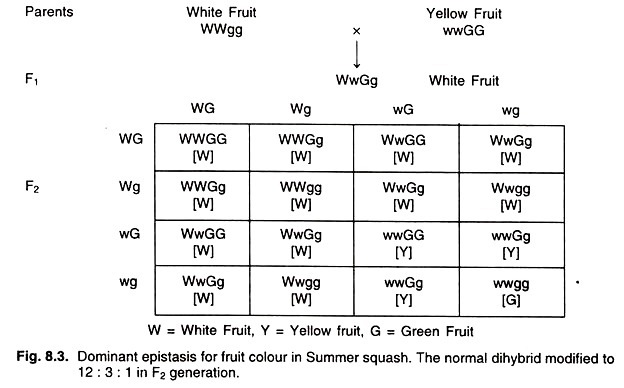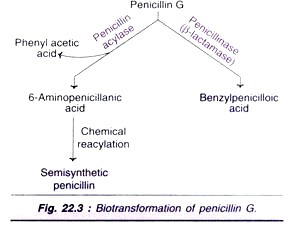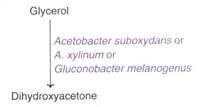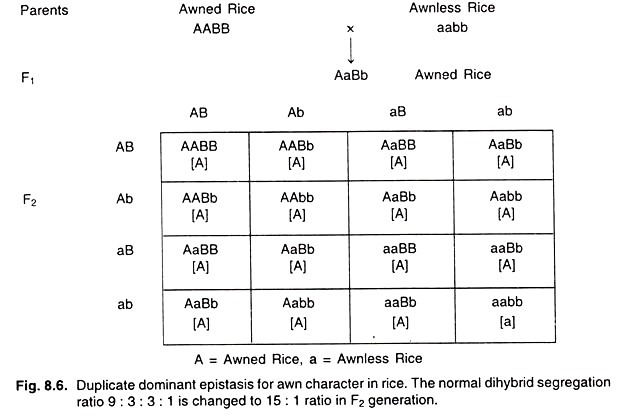ADVERTISEMENTS:
The following points highlight the top six types of epistasis gene interaction. The types are: 1. Recessive Epistasis 2. Dominant Epistasis 3. Dominant [Inhibitory] Epistasis 4. Duplicate Recessive Epistasis 5. Duplicate Dominant Epistasis 6. Polymeric Gene Interaction.
Epistasis Gene Interaction: Type # 1.
Recessive Epistasis [9:3:4 Ratio]:
When recessive alleles at one locus mask the expression of both (dominant and recessive) alleles at another locus, it is known as recessive epistasis. This type of gene interaction is also known as supplementary epistasis. A good example of such gene interaction is found for grain colour in maize.
ADVERTISEMENTS:
There are three colours of grain in maize, viz., purple, red and white. The purple colour develops in the presence of two dominant genes (R and P), red colour in the presence of a dominant gene R, and white in homozygous recessive condition (rrpp).
A cross between purple (RRPP) and white (rrpp) grain colour strains of maize produced plants with purple colour in F1. Inter-mating of these F1 plants produced progeny with purple, red and white grains in F2 in the ratio of 9 : 3 : 4 (Fig. 8.2).
Here allele r is recessive to R, but epistatic to alleles P and p. In F2, all plants with R-P-(9/16) will have purple grains and those with R-pp genotypes (3/16) have red grain colour. The epistatic allele r in homozygous condition will produce plants with white grains from rrP-(3/16) and rrpp (1/16) genotypes.
ADVERTISEMENTS:
Thus the normal segregation ratio of 9 : 3 : 3 : 1 is modified to 9 : 3 : 4 in F2 generation. Such type of gene interaction is also found for coat colour in mice, bulb colour in onion and for certain characters in many other organisms.
Epistasis Gene Interaction: Type # 2.
Dominant Epistasis [12 : 3 : 1 Ratio]:
When a dominant allele at one locus can mask the expression of both alleles (dominant and recessive) at another locus, it is known as dominant epistasis. In other words, the expression of one dominant or recessive allele is masked by another dominant gene. This is also referred to as simple epistasis.
An example of dominant epistasis is found for fruit colour in summer squash. There are three types of fruit colours in this cucumber, viz., white, yellow and green. White colour is controlled by dominant gene W and yellow colour by dominant gene G. White is dominant over both yellow and green.
The green fruits are produced in recessive condition (wwgg). A cross between plants having white and yellow fruits produced F1 with white fruits. Inter-mating of F1 plants produced plants with white, yellow and green coloured fruits in F2 in 12 : 3 : 1 ratio (Fig. 8.3). This can be explained as follows.
Here W is dominant to w and epistatic to alleles G and g. Hence it will mask the expression of G/g alleles. Hence in F2, plants with W-G-(9/16) and W-gg (3/16) genotypes will produce white fruits; plants with wwG-(3/16) will produce yellow fruits and those with wwgg (1/16) genotype will produce green fruits.
Thus the normal dihybrid ratio 9 : 3 : 3 : 1 is modified to 12:3: 1 ratio in F2 generation. Similar type of gene interaction has been reported for skin colour in mice and seed coat colour in barley.
Epistasis Gene Interaction: Type # 3.
Dominant [Inhibitory] Epistasis [13 : 3 Ratio]:
ADVERTISEMENTS:
In this type of epistasis, a dominant allele at one locus can mask the expression of both (dominant and recessive) alleles at second locus. This is also known as inhibitory gene interaction. An example of this type of gene interaction is found for anthocyanin pigmentation in rice.
The green colour of plants is governed by the gene I which is dominant over purple colour. The purple colour is controlled by a dominant gene P. When a cross was made between green (IIpp) and purple (iiPP) colour plants, the F1 was green. Inter-mating of F1 plants produced green and purple plants in 13 : 3 ratio in F2 (Fig. 8.4). This can be explained as follows.
Here the allele I isepistatic to alleles P and p. Hence in F2, plants with I-P-(9/16), I-pp (3/16) and iipp (1/16) genotypes will be green because I will mask the effect of P or p. Plants with iiP-(3/16) will be purple, because I is absent.
ADVERTISEMENTS:
In this way the normal dihybrid segregation ratio 9 : 3 : 3 : 1 is modified to 13 : 3 ratio. Similar gene interaction is found for grain colour in maize, plumage colour in poultry and certain characters in other crop species.
Epistasis Gene Interaction: Type # 4.
Duplicate Recessive Epistasis [9 : 7 Ratio]:
When recessive alleles at either of the two loci can mask the expression of dominant alleles at the two loci, it is called duplicate recessive epistasis. This is also known as complementary epistasis. The best example of duplicate recessive epistasis if found for flower colour in sweet pea.
The purple colour of flower in sweet pea is governed by two dominant genes say A and B. When these genes are in separate individuals (AAbb or aaBB) or recessive (aabb) they produce white flower.
ADVERTISEMENTS:
A cross between purple flower (AABB) and white flower (aabb) strains produced purple colour in F1. Inter-mating of F1 plants produced purple and white flower plants in 9 : 7 ratio in F2 generation (Fig. 8.5). This can be explained as follows.
Here recessive allele a isepistatic to B/b alleles and mask the expression of these alleles. Another recessive allele b is epistatic to A/a alleles and mask their expression.
Hence in F2, plants with A-B-(9/16) genotypes will have purple flowers, and plants with aaB-(3/16), A-bb-(3/16) and aabb (1/16) genotypes produce white flowers. Thus only two phenotypic classes, viz., purple and white are produced and the normal dihybrid segregation ratio 9 : 3 : 3 : 1 is changed to 9 : 7 ratio in F2 generation.
Epistasis Gene Interaction: Type # 5.
Duplicate Dominant Epistasis [15 : 1 Ratio]:
ADVERTISEMENTS:
When a dominant allele at either of two loci can mask the expression of recessive alleles at the two loci, it is known as duplicate dominant epistasis. This is also called duplicate gene action. A good example of duplicate dominant epistasis is awn character in rice. Development of awn in rice is controlled by two dominant duplicate genes (A and B).
Presence of any of these two alleles can produce awn. The awnless condition develops only when both these genes are in homozygous recessive state (aabb). A cross between awned and awnless strains produced awned plants in F1. Inter-mating of F1 plants produced awned and awnless plants in 15 : 1 ratio in F2 generation (Fig. 8.6). This can be explained as follows.
The allele A is epistatic to B/b alleles and all plants having allele A will develop awn. Another dominant allele B is epistatic to alleles A/a. Individuals with this allele also will develop awn character. Hence in F2, plants with A-B-(9/16), A-bb-(3/16) and aaB-(3/16) genotypes will develop awn.
The awnless condition will develop only in double recessive (aabb) genotype (1/16). In this way only two classes of plants are developed and the normal dihybrid segregation ratio 9 : 3 : 3 : 1 is modified to 15 : 1 ratio in F2. Similar gene action is found for nodulation in peanut and non-floating character in rice.
Epistasis Gene Interaction: Type # 6.
ADVERTISEMENTS:
Polymeric Gene Interaction [9:6:1 Ratio]:
Two dominant alleles have similar effect when they are separate, but produce enhanced effect when they come together. Such gene interaction is known as polymeric gene interaction. The joint effect of two alleles appears to be additive or cumulative, but each of the two genes show complete dominance, hence they cannot be considered as additive genes. In case of additive effect, genes show lack of dominance.
A well-known example of polymeric gene interaction is fruit shape in summer squash. There are three types of fruit shape in this plant, viz., disc, spherical and long. The disc shape is controlled by two dominant genes (A and B), the spherical shape is produced by either dominant allele (A or B) and long shaped fruits develop in double recessive (aabb) plants.
A cross between disc shape (AABB) and long shape (aabb) strains produced disc shape fruits in F1. Inter-mating of F1 plants produced plants with disc, spherical and long shape fruits in 9 : 6 : 1 ratio in F2 (Fig. 8.7). This can be explained as follow.
Here plants with A—B—(9/16) genotypes produce disc shape fruits, those with A-bb-(3/16) and aaB-(3/16) genotypes produce spherical fruits, and plants with aabb (1/16) genotype produce long fruits. Thus in F2, normal dihybrid segregation ratio 9:3:3: 1 is modified to 9 : 6 : 1 ratio. Similar gene action is also found in barley for awn length.

